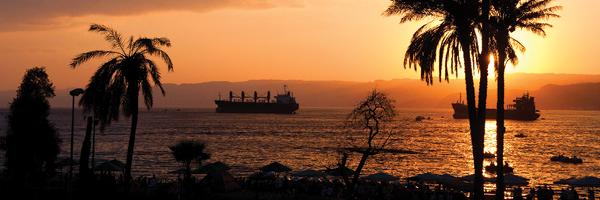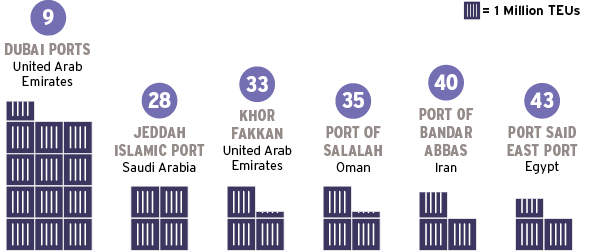Middle East/North Africa: MENA at Work

As Middle East and North Africa (MENA) countries pursue political transformation and economic diversification, transportation and logistics investment is the cornerstone to future growth.
STATS | MENA
UAE Leads by Example
By nature of its location, the Arab world has always been in the middle. From early man’s migration to the transfer of culture and cargo along the Silk Road, to the development of the Suez Canal zone and the world’s foremost trade lane, the Middle East and North Africa (MENA) has been a place of nomadic interludes amid emerging East-West dramas.
Today, the MENA region remains in an uneasy limbo between the extremes of oil-driven affluence and socio-political turmoil. Its fortunes, consequently, are mired in ambiguity.
A recent International Monetary Fund economic outlook describes the Middle East as a “two-speed” region, reflecting the gap that exists between progressive and totalitarian political regimes. The Arab Spring uprisings that beset Libya and Egypt in 2010 erupted into a Syrian civil war that still smolders. Elsewhere, the lingering effects of war in Afghanistan and Iraq, and the ongoing threat of Iran, place MENA in a precarious position.
This volatility contrasts the relative prosperity of Arabian Peninsula economies such as Qatar, Kuwait, Saudi Arabia, Oman, Bahrain, and the United Arab Emirates (UAE)—countries that are rebounding from the global recession thanks to a surge of investment in the transportation and logistics sector, and continuing efforts to diversify domestic industries. Spanning the divide between Asia and Europe, Turkey has become the region’s rising star, thanks to government efforts to privatize industry and diversify the economy beyond traditional agriculture and textile strengths.
Current Affairs
Middle Eastern activities—and their impact on oil and gas markets and global political stability—have long been a U.S. concern, but without much reciprocity in terms of U.S. foreign direct investment (FDI). Apart from the steady buildup of military infrastructure and supplies during the Iraq and Afghanistan wars, outlay in the region is middling at best. U.S. FDI in the Middle East topped out at $35 billion in 2011—the equivalent of Chile’s take—according to the U.S. Bureau of Economic Analysis. The MENA region accounts for less than five percent of U.S. total trade, and one percent of U.S. FDI outflows.
Instead, the U.S. government has used trade and investment incentives as bargaining chips to encourage political transformation throughout the region. For example, Israel, Jordan, Bahrain, and Oman have all entered into free trade agreements (FTA) with the United States. FTAs with Kuwait, Qatar, and UAE have also been proposed.
Absent the dark undercurrent that fuels much of the trade and investment within the region, the Middle East offers relatively little value as either a manufacturing or consumption market. With the exception of the European Union—its top trading partner—and a select core of exported goods—notably oil—the region is economically isolated from the broader global economy.
Countries such as UAE (see sidebar), Kuwait, and Saudi Arabia have endeavored to change this reputation by focusing on high-end commercial and real estate developments to stimulate domestic consumption in an emerging retail sector. They have become oases within an otherwise arid economic landscape.
The Cost of Economic Freedom
If you take the Heritage Foundation’s ranking of the freest economies (see sidebar) at its word, a sizable swath of MENA is “not available” for comment—which speaks volumes. By contrast, Bahrain, Qatar, UAE, and Jordan—countries the Heritage Foundation labels as “mostly free”—all rank in the top quarter of the nearly 200 countries included in the think tank’s annual index.
The Heritage Foundation’s study scorecards “economic freedom” in a number of different areas—in essence, it measures the relative freedom individuals have in determining their economic direction. The disparity between MENA economies demonstrates not only the challenges that exist in establishing macroeconomic stability amid socio-political upheaval, but also the opportunities and motivation for underperformers to seek parity with their peers.
“In promoting economic freedom, it is crucial that nations establish and protect property rights, and combat cronyism and corruption,” writes James Jay Carafano, a senior research fellow for national security at The Heritage Foundation. “As with overthrowing old regimes, these are tasks that will largely have to be the responsibility of the people themselves. They have to win their own future.”
The lack of a “future” is at the core of current incivilities. With few exceptions, MENA countries are burdened by high unemployment, a scourge that continues to thwart social, political, and economic progress.
Air Freight Key to Growth
While the rest of the world is mired in sluggish economic recovery, the Middle East has scored a bonanza in the airfreight sector. Capitalizing on Asian and European misfortunes—and focusing specifically on cargo—state-owned airlines such as Emirates, Qatar Airways, and Etihad are seeing profits soar. In April 2013, Middle East carriers reported freight business expanding at an 8.6-percent clip year-over-year, compared to a 1.4-percent increase worldwide, according to the International Air Transport Association. In 2012, growth was pegged at 11.2 percent.
Global Shipping Super Powers
The Middle East is pushing to supplant European air cargo dominance while re-casting global distribution trajectories. The region’s air cargo hubs are similarly expanding. The Middle East features four airports among the world’s top 50 by tonnage (see sidebar), and Abu Dhabi’s airport posted 25-percent volume growth in 2013 year-over-year. The region is also no stranger to ocean shipping; it is home to six of the world’s top 50 cargo container ports (see sidebar).
The Middle East currently offers a tale of two different types of countries in transition: those that have been plagued by social upheaval and are in the process of major political reform; and stable, oil-producing governments looking to leverage that wealth to diversify economic prospects.
“Each country will define its own unique path, but all paths should converge on accelerated private-sector growth and international trade through structural reforms that deepen trade integration, lower the cost of doing business, foster hiring by private firms, develop high-quality human capital, and expand access to finance,” according to the IMF report.
STATS | MENA
Economic Freedom and Unemployment
The Heritage Foundation’s Economic Freedom Index ranks countries by the relative freedom citizens have in controlling their own labor and property. Lower rankings indicate more freedom. For some countries in the Middle East and North Africa, insufficient data exists to create rankings.
Source: 2013 Index of Economic Freedom, The Heritage Foundation
MENA Cargo Airports in the World’s Top 50
Four airports in the Middle East/North Africa region rank among the top 50 in the world by tonnage. The airports and their rankings are:
Source: 2013 Top 50 Global Airports, Airports Council International
MENA Container Ports in the World’s Top 50
Among the region’s container ports, Dubai Ports leads as ninth in the world by tonnage. Five others in the top 50 rank as follows:
Source: 2011 World Port Rankings, American Association of Port Authorities
UAE Leads by Example
When the global recession hit Dubai, United Arab Emirates (UAE), the effect was immediate. Rampant spending on extravagant real estate properties screeched to a halt. A city born from oil opulence was suddenly cut off from its lifeblood: credit. Then an interesting thing happened. Developers shifted focus from luxury to logistics, banking on a more reliable foundation for future economic growth.
Dubai World Central’s planned logistics corridor is the centerpiece for this emerging vision. Al Maktoum International Airport—the first phase of which opened in 2010—aspires to be the largest all-cargo airport in the world, capable of accommodating more than 13 million tons of freight. The gateway, which spans 77 miles, also features the established Jebel Ali Port—the ninth-largest container port in the world—and the Jebel Ali Free Zone. The new development complements the existing Dubai International Airport, which already ranks as the world’s fifth-largest cargo hub in tonnage.
The Emirates’ air cargo capabilities offer a complementary piece to the Middle East’s long-standing jewel: the Suez Canal. Asian manufacturing shifts westward, and the on-again-off-again emergence of India as a sourcing location, will add bandwidth to the world’s foremost trading lane. There’s also the promise of economic development in Central Asia from Pakistan north to the Russian border, as well as the untapped potential of Africa. While recent labor strife in Egypt has raised speculation about the threats of closure, the Suez Canal remains the cornerstone of Eurasian trade.



